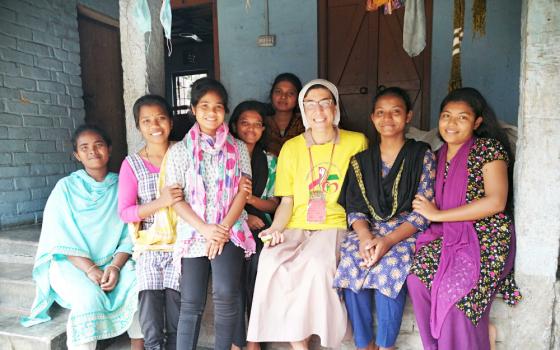As I continue to reflect on the “Lost? Twenty-Somethings and the Catholic Church” conference hosted at Fordham University last month, I keep returning to the opinions of Robert Putnam on the vital importance of the church for immigrant communities.
Putnam is co-author of American Grace: How Religion Unites and Divides Us, which, only months after its October 2010 publication, has already become the “go to” book for those seeking information and insights into the state of religious culture in the U.S.
Putnam credits the thriving of the Catholic Church in the U.S. in the late nineteenth and early twentieth centuries on its ability to provide a refuge for immigrants. As thousands flooded into the U.S., they were fearful of their new, foreign surroundings and typically suffered with destitution and persecution. The parish offered them rituals and traditions that were familiar, and organized them into a supportive, insulated community.
The Catholic Church offered immigrants the best of what religious groups can offer.
As Lawrence Cunningham of Notre Dame University writes, one of the most important functions of a religious community is to “provide refuge from the pressures and fears (real or imagined) of social change and/or disruption. The close bonds of such groups set up a kind of umbrella under which people can feel secure.”
This explains in part why, even to this day, the church remains so vital and influential in parts of the world that are wracked by violence, poverty, and political and social instability. It also explains why Latinos now form the backbone of Catholic lay participation in the U.S.
The church provides them refuge from their ongoing struggles with poor working and living conditions as well as increasingly xenophobic immigration laws. In exchange, Latinos keep the church from catastrophic collapse in this country.
Allegiance to the Catholic Church in the U.S. began to falter as the children and grandchildren of immigrants assimilated into American society both ethnically and religiously.
“As ethnic identities faded over the generation, they become less Catholic and more like other Americans,” Putnam notes. And as the discrepancy between the views of laity and the institutional church grows, their commitment to Catholicism weakens as well.
Will Latino Catholics follow a similar trajectory in the decades ahead?
Another panelist at the “Lost?” conference, Marilyn Santos, who works in youth ministries for the Archdiocese of Atlanta, suggested that the adoption of the English language by Latinos correlates with their decreased Catholic affiliation. Citing a 2000 Pew Hispanic Center study, Santos said that the allegiance Latinos have to Catholicism drops from 74 percent among first generation Americans to 62 percent among the third generation.
So what happens to new generations of baptized Catholics when they grow up immersed in socially and economically stable American culture?
The “Lost?” conference attempted to answer that question with a short video of interviews with young adult Catholics and former Catholics, captured in guerilla filmmaking style.
What made the film most striking was that the interviewees were randomly selected members of the millennial generation found strolling through parks or hanging outside of restaurants. They weren’t the typical young adult stakeholders found on Catholic college campuses or in graduate programs in theology.
And yet, the themes of each interview followed a similar pattern.
Every person interviewed had an aversion to the institutional church’s stances on women, gays and lesbians, and mandatory celibacy for the clergy. All those who attended church struggled to find people from their generation to connect with in their parishes. Most felt that their parishes catered to senior citizens and young families with children. Almost every student resonated deeply with the Church’s social justice tradition. And all interviewees mentioned that they were longing for community.
All of these twenty-somethings were searching for a refuge, but few could find solace in an institution that revokes its welcome based on issues like gender or sexual orientation. They could hardly find a sense of safety in a church that would disinvite them from the Eucharistic table because of differing convictions about political or social concerns.
Though the film drew from a small sampling pool, the opinions expressed are supported by exhaustive research. Of the twenty-something Catholics polled for American Grace, 80 percent want to see women in the clergy, 75 percent favor same-sex marriage, and only 15 percent attend Mass regularly.
Young adult Catholics are still looking for a place of refuge, but not because of fears of social change or disruption. Rather, they are searching for human connection in a world that increasingly unfolds in virtual reality. They are seeking ways to make meaning and live authentically in a media culture dominated by entertainers and extremists.
Tami Schmitz, a campus minister at the University of Notre Dame, reinforced this point.
The young people she meets on campus are yearning for community. “They want someone to know, listen to and treasure their stories. They want a home where they are known and loved,” she said
But this does not seem to be the refuge that the institutional church is willing or able to provide for the vast majority of new generations of Catholics.
Of the millennials who still practice Catholicism, 10 percent describe themselves as highly orthodox. Most studies suggest that this group will form the core of the Roman Catholic Church in the U.S.
It is this group of young Catholics for whom the church gladly provides a refuge: those who live in fear of changes in society that have brought greater equality and justice, particularly for women and LGBT persons.
It’s for those who, like the hierarchy, are seeking an umbrella of security in the forms of absolutism and unquestioning conformity.
“In community you can’t get lost -- someone will miss you,” commented Schmitz at one point in her reflection.
But to those 90 percent of twenty-somethings who do not fit in the “highly orthodox” category, the institutional church is communicating the very opposite this message.
Instead of offering them community and a refuge, the hierarchy tells them they will not be missed and, in fact, that the church would prefer it if they would “get lost.”
[Jamie L. Manson received her Master of Divinity degree from Yale Divinity School where she studied Catholic theology and sexual ethics. Her columns for NCR earned her a first prize Catholic Press Association award for Best Column/Regular Commentary in 2010.]
| Editor's Note: We can send you an e-mail alert every time Jamie Manson’s column, "Grace on the Margins", is posted to NCRonline.org. Go to this page and follow directions: E-mail alert sign-up. If you already receive e-mail alerts from us, click on the "update my profile" button to add "Grace on the Margins" to your list. |



